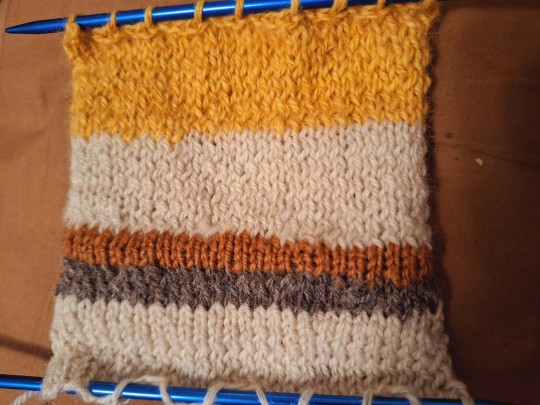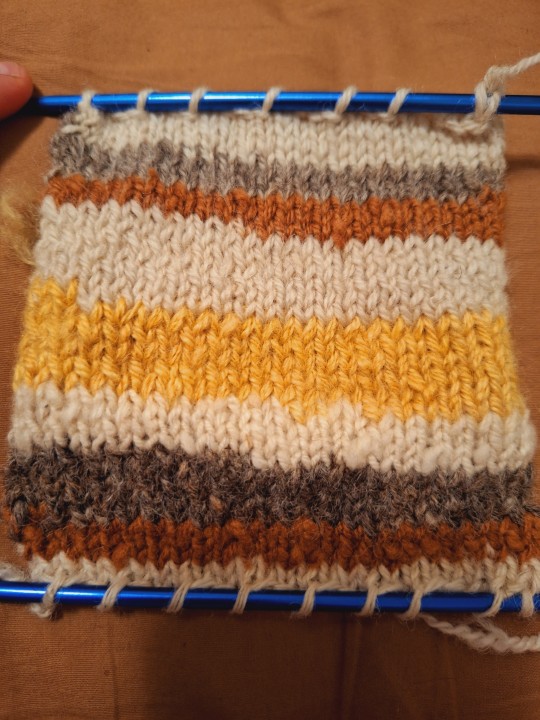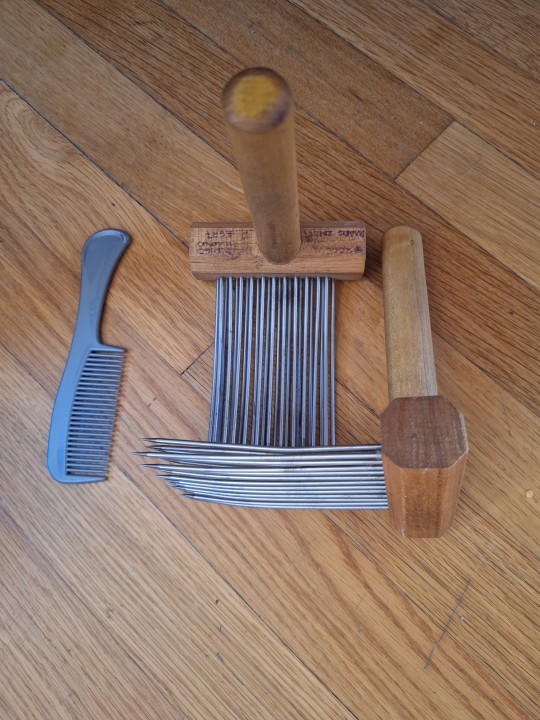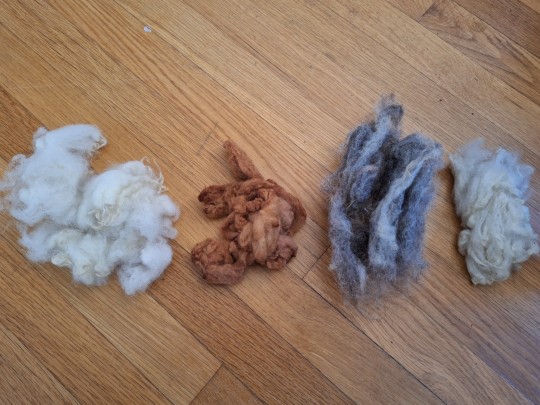#i dont think my squares are very even unfortunately. the different singles and breeds all puffed up differently so the gauge isnt great lol
Explore tagged Tumblr posts
Text
Finished knitting the samples (I don't know where my blocking pins are, sorry).



readmore because this was just obnoxiously long and i couldn't manage to easily condense it further. am gonna post a much shorter little summary in a bit though.
The square on the left is the hand combed stuff (the yellow is hand combed as well), the square on the right is the palm combed and picked combined--I trust you can tell which is which, but in case not, the picked is much more textured lower section, and the yellow yarn separates the two preps. (I added it in part because I wanted to do another test prep and spin just to measure the prepping time, which I talk about more below). The yellow in that square is just palm combed--I didn't do any picked yellow at all.
The bottom image shows both squares folded in half so you can see the halo (fancy word for the soft fuzz that surrounds all wool yarn, which is very easy to see when knit like this, if you didn't know)--I don't actually know if less halo=fibers more aligned (i.e. better worsted) or if it's just correlation, but you can see that the picked yarn in particular has quite a lot of halo compared to the others.
Regardless, while there's a little bit more of a halo on the palm combed than the hand combed, they don't feel noticeably different, and I don't think anyone not already aware that only one was produced on actual hand combs would notice or batt an eyelash.
I didn't actually take any pictures of my timed test (wasn't much to photograph, had a migraine, and I don't necessarily think that the numbers mean a whole lot per se), but it was using aforementioned yellow rya lambswool fleece, which are medium long, very curly, and somewhat crimpy. I just combed a double handful's worth of locks on my hand combs and palm comb each.
The hand combs took about 10 minutes; the palm comb about 13. This definitely indicates to me that a palm comb is as viable a way to get through a fleece as hand combs are, even if it may be slower. I say may because I have far less experience with a palm comb than with my hand combs, and I have become faster with all my fiber prep tools with time. Of course, everyone is different speeds on different tools anyway, so I don't think "faster or slower than hand cards" is as helpful of a metric as "in roughly the same range as hand cards".
I will also say that the processing time when I was doing five different breeds varied quite a bit depending on crimp, staple length, and amount of vm. The fastest fiber to process on the palm comb was that Ouessant, which had a medium staple length, not much crimp, and zero vm (on hand cards, fastest was Rambouillet). The more crimp there is the more the locks want to maintain their structure, so they need to be physically combed open more, which takes longer no matter what tool you're using, to varying extents (and the rya I tested just now is extremely crimpy). Very short fibers and very long fibers both add time, as does additional vm. All of that is also true for hand cards, but hand combs are better equipped to deal with those issues, since you can pass fiber back and forth, since you have much more space on the tines, and since you can comb from several directions.
So palm combs seem to do best with medium length, fairly straight fibers with little to no vm, but can handle fibers that are none of those and still end up with a spinnable product--even a pretty damn good product, in most cases. I wouldn't call the palm combed Cormo very successful--it was definitely slower to prep that short of a staple length (1 inch/2.5cm) on the palm combs, to the extent that I didn't process it completely bc it was just taking so long.
That test did also show a few other things that I hadn't been looking for; notably that the hand combs produce way more combing waste. With palm combs, you're almost never leaving usable fibers behind on the tines unless they're all tangled and knotted from haphazard loading, since you're always pulling it off by hand. Whereas on hand combs, you do that every time you finish transferring the fibers from one comb to the other, unless you want to spend a lot of extra time trying to get the last few or get them by hand (maybe this is less of an issue if you use them with one secured to something--I never have, so I don't like to put one comb down because it's so sharp and dangerous). So my combing waste pile for the hand cards has tons of usable fibers that were just left on the combs, whereas my palm comb waste pile is almost entirely short or knotted fibers.
You can of course reprocess hand combing waste to get those long fibers back--but that adds a significant amount of extra time.
Anyway, im gonna try and condense all of this into a single much shorter post tomorrow, but im really excited about these results--this $2 USD plastic comb is literally a smaller mutated pair of $90 USD hand combs (with those having been a bargain--you often see $150+). Like... that's also much cheaper than hand cards are --those have skyrocketed in price recently, geez... almost $80 USD if you want a pair with a decent size brush, so that would definitely a gamechanger there.
So, I wanted to get back to that palm comb idea, especially since I finally found what I think is a good comb to use. I'm going to try comparing three methods--hand combing, palm combing, and then just teasing by hand.

Left: the comb for palm combing. This is just a cheap plastic hair comb--the only crucial thing that I'm aware of so far is that the tines need to be evenly spaced (so not one of those graded combs that are fine at one end) and not too close together.
Right: my hand combs. These are just standard two row combs, nothing special or particular about them.

The fibers, from left to right:
1. Ouessant. Stand in for your average fairly fine medium length wool.
2. Cormo (looks all weird bc it's been dyed with baking soda as a modifier, which tends to clump it. Not felted). Very short stapled wool, very fine.
3. Jacob. This particular Jacob is a little greasy and quite strong. Stand in for any coarse wool.
4. Rambouillet. Very fine, but also tons of fine vm. Want to see if I can get any of that out--it's the kind that's too fine to pick out by hand, so.
I already know the palm comb can produce a somewhat worsted prep--but I never did figure out how to spin true worsted yarn on spindles of any kind, and can only do it on my wheel. So I'm going to try spinning all three preps on my wheel into a worsted yarn, and see how they compare.
I also want to figure out a little bit more about speed--I think the palm combs are slightly faster, so if they're almost as good a prep, that would be a good advantage !
Will do all my preps and report back with pictures.
#again--if anyone knows about these or something very similar pls let me know#id love to read about them ive just not been able to find any mention of this type of comb used as a hand comb for wool myself#i dont think my squares are very even unfortunately. the different singles and breeds all puffed up differently so the gauge isnt great lol#i like how they look though. i would love those colors in a self striping sock yarn actually.....#i dont know about using different breeds within the same sock though... i could do it in just rya jacob and shetland and cut out the other#(or just rya and jacob but the gray is a very different fleece from the white which is a lambsfleece--so softer and shorter.#not an improvement there)#but if theyd stretch different and if it was enough to notice that would drive me insane and id never wear them#cool to remember though#spinning#handspun yarn#shetland#cormo#jacob#ryå lambswool#rambouillet#ouessant#palm comb#hand comb#wool prep#experiment
180 notes
·
View notes